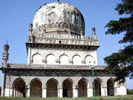The secular nationalism of Urdu: Kavita Saraswathi Datla’s The Language of Secular Islam reviewed by A. Faizur Rahman, The Hindu 30 Sept 2013
Extract:"For Osmania University was neither a communal nor theological project despite the fact that it did have a faculty of Theology. According to statistics provided by Datla, by 1935 there were 1,806 students in the Osmania system: 771 in arts, 731 in sciences, 102 in medicine, 97 in law, 47 in engineering, 26 in education and only 32 in theology. In other words, theology was not a popular course a fact that indicates Muslim eagerness to be part of the secular mainstream.
It is Datla’s case that such a tendency was encouraged by the Osmania University. She highlights two specific projects that were commissioned by the University which emphasised the highlighting the secular achievements of a Muslim past that would serve India well. They were, Taarikh-e-Hind (The History of India) by Sayyid Hashmi Faridabadi and Taarikh-e-Islam (The History of Islam) by Abdul Halim Sharar. These two histories, writes Datla, “claim space for Muslims within national and global narratives by asserting the importance of Muslims to the larger themes and imperatives of history and development.” “What Sharar and Faridabadi hoped ultimately to demonstrate was the compatibility of national and Islamic goals.”
...The book also contains an extensive discussion on student politics in Osmania University, particularly the controversy surrounding the singing of Vande Mataram. She refuses to accept that this imbroglio was part of the freedom struggle in Hyderabad, or proof of anti-Hindu policies of the Nizam. She recounts how when (in November 1938) some students started singing the Vande Mataram in their hostel prayer rooms they were asked not to sing because the song, given its “political and controversial nature”, had the potential to hurt the feelings of non-Hindus.
Not surprisingly, this was sought to be exploited by the Hyderabad State Congress and the Hindu Mahasabha. This, despite the fact that the striking students did not define their agitation in communal terms." Continue reading The Hindu
About the book:
During the turbulent period prior to colonial India’s partition and independence, Muslim intellectuals in Hyderabad sought to secularize and reformulate their linguistic, historical, religious, and literary traditions for the sake of a newly conceived national public. Responding to the model of secular education introduced to South Asia by the British, Indian academics launched a spirited debate about the reform of Islamic education, the importance of education in the spoken languages of the country, the shape of Urdu and its past, and the significance of the histories of Islam and India for their present.
The Language of Secular Islam pursues an alternative account of the political disagreements between Hindus and Muslims in South Asia, conflicts too often described as the product of primordial and unchanging attachments to religion. The author suggests that the political struggles of India in the 1930s, the very decade in which the demand for Pakistan began to be articulated, should not be understood as the product of an inadequate or incomplete secularism, but as the clashing of competing secular agendas. Her work explores negotiations over language, education, and religion at Osmania University, the first university in India to use a modern Indian language (Urdu) as its medium of instruction, and sheds light on questions of colonial displacement and national belonging.
Grounded in close attention to historical evidence, The Language of Secular Islam has broad ramifications for some of the most difficult issues currently debated in the humanities and social sciences: the significance and legacies of European colonialism, the inclusions and exclusions enacted by nationalist projects, the place of minorities in the forging of nationalism, and the relationship between religion and modern politics. It will be of interest to historians of colonial India, scholars of Islam, and anyone who follows the politics of Urdu. Source: University Of Hawai'i Press.






